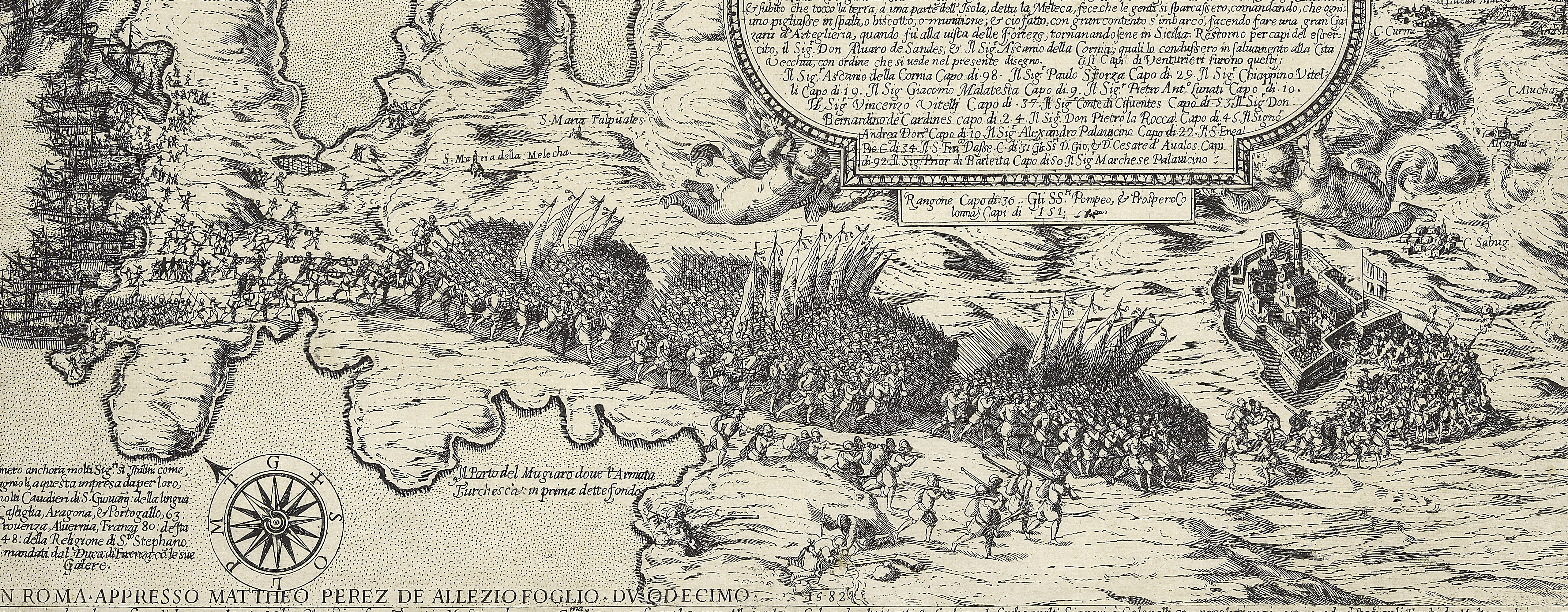
Ottoman-Habsburg Wars (1521-1791)
Images from eight wars fought between 1570 and 1718
Map of Budapest, 1686 (Budapest, Hungary) 47°28ʹ52ʺN 19°02ʹ23ʺE
1686 or laterEtching and engraving; printed on paper; laid down on coarse linen | Scale: not stated | RCIN 724037
An example of this map in the BNF (Ge D 3037; 29691) has the manuscript inscription, in a nineteenth-century or early twentieth-century hand, above the top border: ‘Siège et prise de Bude par le prince Charles de Lorraine et l’Electeur de Bavière’. It would appear that this plan was published in a volume; the explanatory key which was printed in the body of the text has, in the BNF example, been cut out and pasted along the bottom on the map. The explanation of the letters is as follows:
A. Le Chasteau.
B. Bude.
CCC. La Basse-Ville.
D. Pest.
E. Endroit où il y a quatres cens hommes de Garnison.
F. Attaque de M le Prince Charles de Lorraine.
G. Attaque de M l’Electeur de Baviere.
H. Redoute.
I. Montagne de Saint Ger-bard.
L. Attaque des Troupes de Brandebourg.
M. Endroit par où la Basse-Ville a esté prise.
N. Nouvelle Batterie faite par les Turcs.
O. Petit Ruisseau.
P. Endroit où estoit le Pont que les Turcs ont brûlé quands ils ont abandonné Pest.
Q. Endroit marécageux.
Although the cartographer of this map is not known, it is possible that it might have been Johann Kleinwächter. J. Bérenger, stated that: ‘Dès cette époque [early 17th century] la cartographie avait fait de grands progrès et les méthodes de relevé du terrain étaient déjà au point. Les ingénieurs militaires n’avaient en principe aucune formation artistique mais ils étaient capables de dessiner avec précision fortifications, bâtiments ou paysages. Leurs dessins n’avaient que des buts pratiques, ils étaient utilisés durant les opérations et étaient joints aux rapports, de sorte qu’ils se trouvent dans les archives. Johann Kleinwächter est le premier ingénieur militaire dont les plans de sièges des campagnes de Hongrie ont été publiés. Recruté en 1679, il est en 1684 en poste à Györ et prend part au siège de Bude; jusquà sa mort en 1686 il est le chef des ingénieurs militaires du théâtre d’opérations.’
For further reading, see:
J. Bérenger, ‘Le siège de Bude de 1686’, Dix-septième Siècle, vol.4, no.229, 2005, pp.591-611.
Condition: six old fold lines; brown stains across face of map. Verso: water-stained patch, top left, from the removal of Cumberland's cipher label with some remnants of the label.
Anonymous (cartographer)
Subject(s)
Army-ImperialWatermark: Indistinct
Condition: six old fold lines; brown stains across face of map. Verso: water-stained patch, top left, from the removal of Cumberland's cipher label with some remnants of the label
Scale: not stated
21.2 x 33.5 cm (image)
[cropped] x 33.7 cm (platemark)
20.8 x 33.1 cm (neatline)
21.4 x 34.5 cm (sheet)
Printed title:
PLAN DE BUDE [top centre]
Annotations:
George III heading: Buda besieged by the Imperialists 28 June and taken 2 Sep. 1686.
Other annotations: (Recto) [top right and bottom left, black pencil:] 2d Sept 1686. (Verso) [top right, not entirely legible, obscured by white paper strip:] Buda & Hungary; [bottom right, black pencil:] 67; [bottom left, obscured by canvas backing:] 66; [centre, red pencil:] 70.
George III catalogue entry:
Buda Plan de la Ville de Bude assiegée par les Imperiaux, commandée par le Duc de Lorraine, le 28 de Juin et prise par assaut le 2 de Septembre 1686.
Subject(s)
Budapest, Hungary (47°28ʹ52ʺN 19°02ʹ23ʺE)
Bibliographic reference(s)
J. Bérenger, ‘Le siège de Bude de 1686’, Dix-septième Siècle, 4, no. 229, 2005, pp. 591-611.
Page revisions
3 November 2024
Current version






